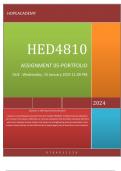Exam (elaborations)
HED4810 ASSIGNMENT 05-PORTFOLIO 2024 DUE : Wednesday, 15 January 2025 11:00 PM Question 1: Defining inclusive education Based on everything you learned from the module HED4810: Putting Inclusive Education into Context, formulate a definition of inc
- Course
- HED4810
- Institution
- University Of South Africa (Unisa)
HED4810 ASSIGNMENT 05-PORTFOLIO 2024 DUE : Wednesday, 15 January 2025 11:00 PM Question 1: Defining inclusive education Based on everything you learned from the module HED4810: Putting Inclusive Education into Context, formulate a definition of inclusive education that the Basic Education...
[Show more]



